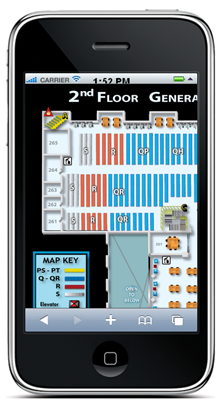The hard-working co-chairs -- Susan Fingerman, Ashley Conaway, and Chris Olson -- and their colleagues in the Maryland chapter of SLA did a fine job of presenting interesting information from many disciplines.
Highlights
- Opening Presentation -- Mary Ellen Bates
-- RFID tags are used to track cattle, railroad cars, and runners in races; in passports, EZ passes, and ski passes
-- YouTube has old advertisements such as the telephone "dial vs. touch tone"
Young people:
- Distance doesn't matter, and it's not rude to be talking/texting while you're with your friends; it's actually inclusive
- Everybody shares (they don't get the copyright concept)
- Everybody discusses (friend-sourcing; e.g., showing friends on the iPhone 4 the clothing on the rack and asking for opinions)
- Expect a lot of value: they already *have* more info than they can use; just saying that our stuff has more value is not a good enough argument
- They want continuous JIT (just in time) learning; want context-sensitive video or streaming media right there all the time
In 5-10 years, who will we be hiring and for what kind of job? We'll be hiring the people who can add value to that middle ground.
Finally: in response to the question, "what do you do?," she replies "I do things with information." This is interesting and it also keeps you from being pigeon-holed.
2. Navigating Government Data
This was one of four concurrent sessions: E-Book Insights had reps from Knovel, Books 24x7, and NetLibrary; and there were also sessions on Business Research and Sci/Tech Resource Gems.
I think that the best-kept secret on the whole WWW is the enormous amount and excellent quality of U.S. government information there. A great deal was discussed during this session, so here are the most important items:
- usa.gov - the government's web site (also has list of federal libraries)
- data.gov - last year the "open government directive" said that all agencies must publish three datasets of their own choosing by January 2010. ((Featured item on home page is the geospatial data with a new interactive platform.)
- Most of their 100+ databases are free and have been around for a while. The well-known Chemistry Webbook has recently been updated
- NIST also has a museum and historical collection
- Journal of Research of NIST is now online from 1995 (PDF's)
- Lots of census data such as the American Community Survey, which gets new data every year and not just every 10 years
- One year of data is now available for 2009; in December, five years of data (2005-2009) will be available, and in January 2011, three years of data will be available (2007-2009)
- From the 2010 decennial census, redistricting data will be available February 2011
- New platform for American Factfinder in January 2011!
- MD State Data Center also has county-specific info, and estimates and projections on housing, migration, income, jobs, demographics, and more
- Every state has a state data center, and they are run by different organizations, such as the state, a library, or a university, and they all have different resources
This sessions two speakers were Mary Ellen Bates to talk about Google stuff, after the Google person canceled at the last minute, and Gary Price.
Google is so huge and diverse now that all a speaker can do in a limited time is hit cool highlights. For example:
- Google New - Where to find Google's new products. You can search and then search within results
- Google Public Data Explorer - Provides data and datasets from other sources such as Eurostat and OECD, such as "broadband penetration in Europe" and "natural fast prices." Both U.S. and international information are covered.
- Google Fusion Tables - Upload your data and choose many ways to visualize your results; e.g., map, pie/bar chart, timeline)
- Clicker.com- A guide not only to TV listings but to lectures, some live streams, and interviews.
- MetaLib - From GPO, yes, a federated search tool for government databases! (Just launched 10/18!)
- Wolfram Alpha - A search engine/calculator for many things; e.g., historical weather, historical stock charts
- NNDB (Notable Names DataBase) - This one was creepy. It basically links people to other people so that connections -- e.g., employers, schools, relatives -- between them can be seen. For example, here's Ayn Rand's page. Go to the bottom and click "create a map," and then start mousing over things.
- Marinetraffic.com - Find the location of tankers, tugs, passenger vessels, etc. and more. Updates every 20 seconds.
- Openlibrary.org - free books and can send them to Kindle.
We are supposed to get a link to most of the program on the web, and I'll update this post with that when it arrives.

